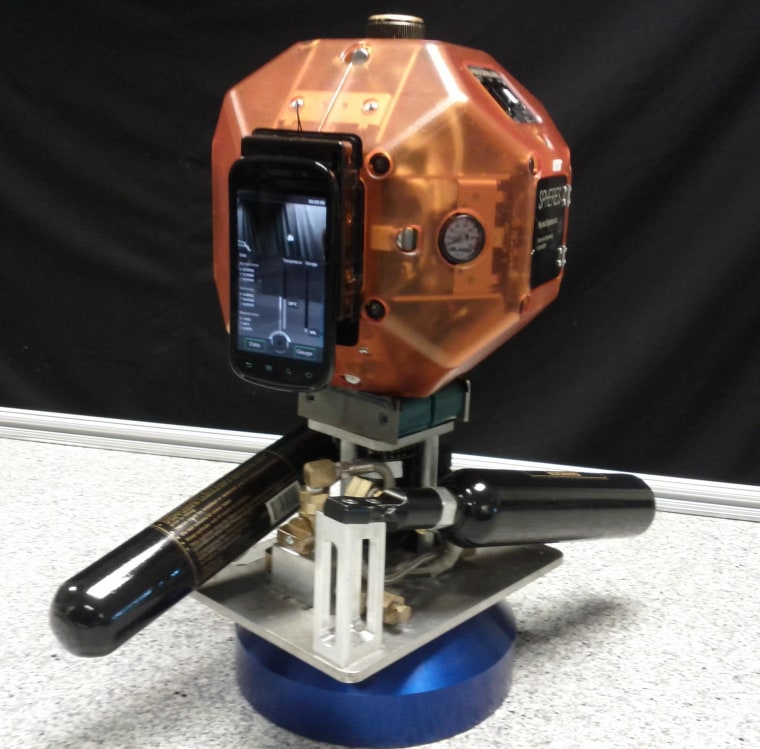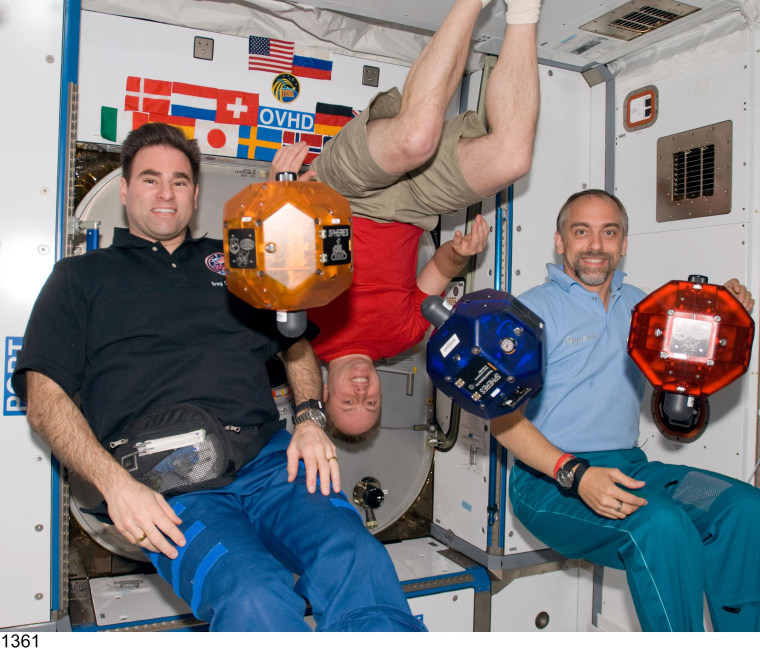HUNTSVILLE, Ala. — NASA has pioneered new technologies on the International Space Station for years, but the space agency's latest technological twists are venturing into science-fiction territory.
For example, the next generation of camera-equipped, free-flying robots could usher in an age when remote-controlled gizmos check out the space station's far corners, unassisted by humans on board. But couldn't that open the way for a robot to go rogue, as HAL did in "2001: A Space Odyssey"?
"It's our job to make sure that doesn't happen," Jose Benavides, chief engineer for the SPHERES robotic flier program at NASA's Ames Research Center, told NBC News.
Benavides and other researchers provided an update on space station innovations on Monday during a televised forum at NASA's Marshall Space Flight Center in Huntsville. SPHERES — which is short for "Synchronized Position Hold, Engage, Reorient Experimental Satellites" — ranks as one of the station's longest-running tech experiments.
Robots with enhanced vision
Astronauts have been testing the gas-propelled, beachball-sized satellites since 2006, but just recently the SPHERES devices have been rigged up with Android smartphones to enhance their vision and intelligence. The station's three spaceballs can now use a Kinect-style 3-D scanning system to map their environment.
Sometime next month, the flying robots are due to venture out of their home base in the Japanese Experiment Module for the first time, Benavides said. Eventually, they'll be given the run of the entire space station.
Suppose Mission Control wants to check out an anomalous reading on one of the space station's displays. "Without having to bother an astronaut, the ground operator can navigate the SPHERES over to take a look," Benavides said.
The robot can also be sent to look for, say, a missing wrench while the astronaut who lost it is otherwise engaged. "A lot of the astronauts' time has been spent looking for things," Benavides explained.

Heading off HAL
Meanwhile, Benavides and his teammates spend a lot of their time working through even the most unlikely scenarios — for example, a stray gamma-ray blast that somehow scrambles the SPHERES software — to make sure a flying robot won't turn into a mini-HAL. "Even if all the wrong things happen, it can't hurt anybody or do any damage," he said.
NASA's technology team is also working on a more advanced breed of spaceballs, which will run on rechargeable batteries and operate for at least 10 hours continuously. NASA has issued a challenge that offers $1,000 for the best mission patch and name for the project. (Maybe anything HAL-related wouldn't be the best suggestion.)
Here are some of the other technological twists featured during Monday's forum:
- The first 3-D printer carried into space could get its first orbital tryout next month, said Niki Werkheiser, NASA project manager for the 3-D Printing in Zero-G technology demonstration. There's a window of opportunity to produce more than 20 plastic test items, which could be returned to Earth for inspection at the end of the next SpaceX Dragon cargo resupply mission. The 3-D printer was provided by a commercial venture called Made In Space, which is now working on a more advanced printer for the space station. The first utilitarian items to be made in orbit are likely to include everyday items such as sample containers — and maybe a replacement for that astronaut's missing wrench.
- The space station's water-recycling system has been recapturing 90 percent of the water that's used by the crew in orbit — including almost all the water contained in the crew's urine. "I have drunk the water, and it's perfectly fine," said Robyn Gatens, manager for ISS systems and technology demonstrations. "It's cleaner than tap water." She said engineers are planning to tweak the system, to recover even more water from the "really icky" concentrated urine that is currently left behind by the process.
- The station is also trying out a contraption known as the Space Communication and Navigation Testbed, or SCaN Testbed, which capitalizes on a technology known as software-defined radio. The mode of communication can be automatically shifted between frequencies to minimize interference and maximize the signal's capabilities to send voice communication, video or telemetry. During a future mission to Mars, a successor to the SCaN Testbed could adapt the astronauts' communication system to use laser signals or radio signals, depending on the situation, said principal investigator Richard Reinhart of NASA's Glenn Research Center.
